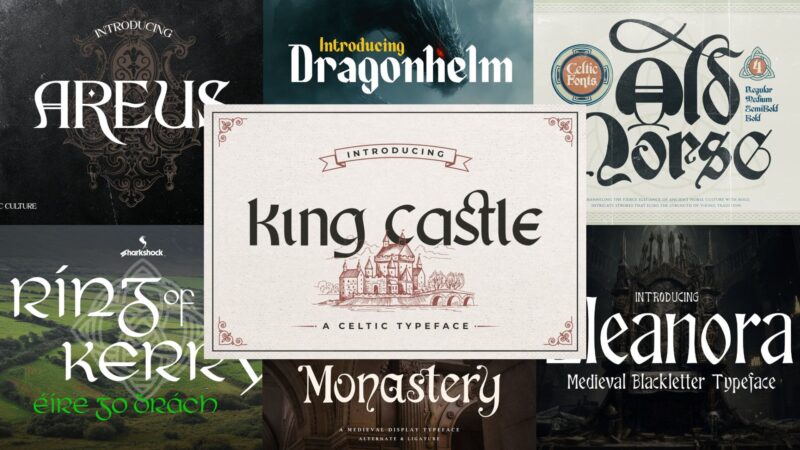In this article:
- What Makes a Font "Celtic"?
- Celtic Fonts vs. Irish Fonts: Understanding the Difference
- The History Behind Celtic Typography
- The Best Celtic Fonts of 2026
- How to Choose the Perfect Celtic Font for Your Project
- Where to Use Celtic Fonts (And Where to Avoid Them)
- Tips for Using Celtic Fonts Effectively
- Common Celtic Font Mistakes to Avoid
- Celtic Fonts in Digital Design
- The Future of Celtic Typography
- Conclusion: Embracing the Celtic Spirit in Your Designs
There’s something absolutely mystical about stumbling upon an old Celtic manuscript in a dusty library corner. Those intricate knots, flowing letterforms, and ornate capitals seem to whisper tales of ancient druids, medieval monks, and forgotten kingdoms.
Celtic fonts capture that same enchanting spirit, bringing centuries-old typography into our modern digital world. Whether you’re designing a fantasy novel cover, creating branding for an Irish pub, or adding some historical flair to your next project, Celtic fonts offer a direct connection to one of history’s most beautiful writing traditions.
But here’s the thing – not all Celtic fonts are created equal. Some nail that authentic medieval manuscript vibe, while others feel more like Halloween decorations gone wrong. In this deep dive, we’ll explore everything you need to know about Celtic fonts, from their rich historical roots to the best options available in 2026.
So grab a cup of tea (or maybe some Irish whiskey), and let’s embark on this typographic journey through the misty landscapes of Celtic design!
Old Norse
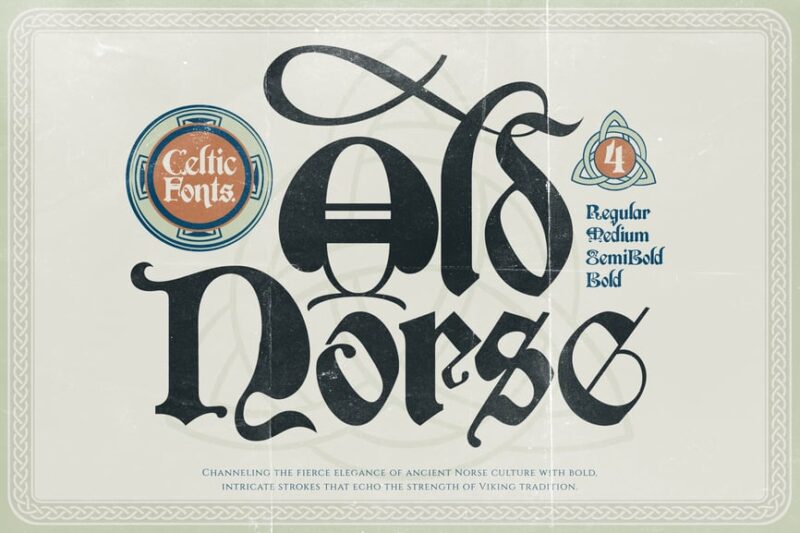
Old Norse is a decorative Celtic font that captures the essence of medieval and Viking aesthetics. With its rugged and bold appearance, this font is perfect for projects that require a strong, historical Celtic vibe, such as book covers, posters, or game designs.
King Castle – Celtic Typeface

King Castle is a regal Celtic typeface that combines medieval and royal elements. This decorative font is ideal for creating Celtic-inspired designs with a touch of majesty, making it suitable for branding, packaging, or historical-themed projects.
Ring of Kerry

Ring of Kerry is a script and handwritten Celtic font that incorporates Irish and ribbon-like elements. This decorative typeface offers a more fluid and organic approach to Celtic design, perfect for creating invitations, logos, or packaging with a touch of Irish charm.

Get 300+ Fonts for FREE
Enter your email to download our 100% free "Font Lover's Bundle". For commercial & personal use. No royalties. No fees. No attribution. 100% free to use anywhere.
Monastery – A Medieval Display Typeface

Monastery is a decorative medieval display typeface with Viking influences. This Celtic-inspired font evokes a sense of ancient wisdom and strength, making it an excellent choice for historical documentaries, book covers, or any design requiring a strong, Celtic presence.
Areus – Celtic Vintage Logo Font
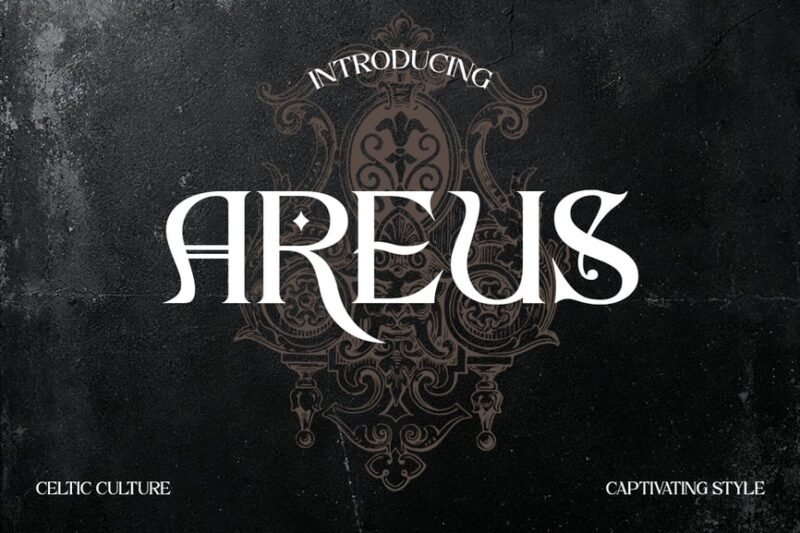
Areus is a serif Celtic font designed for vintage logo creation. This typeface combines medieval elements with a timeless appeal, making it ideal for branding projects that require a Celtic touch while maintaining a classic, vintage aesthetic.
Dragonhelm – Medieval Typeface
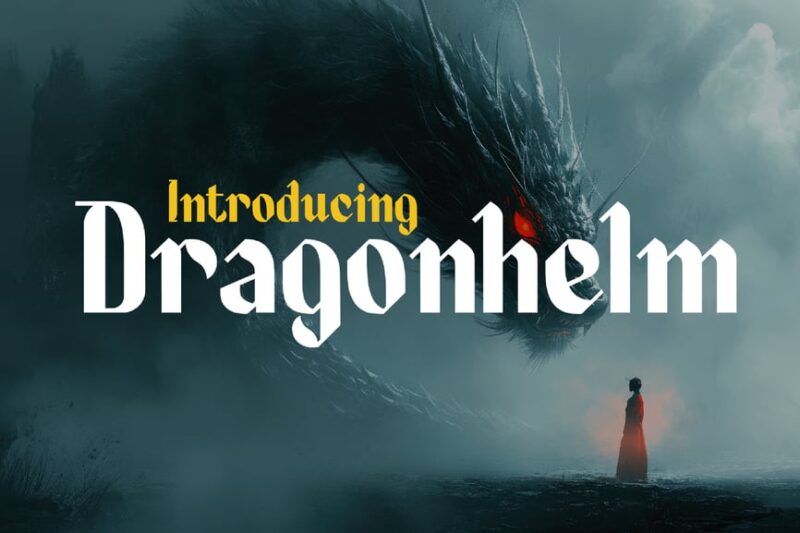
Dragonhelm is a decorative medieval typeface that embodies the spirit of Celtic design. With its bold and ornate characters, this font is perfect for creating eye-catching headlines, logos, or themed designs that require a strong Celtic or medieval presence.
Celtrick
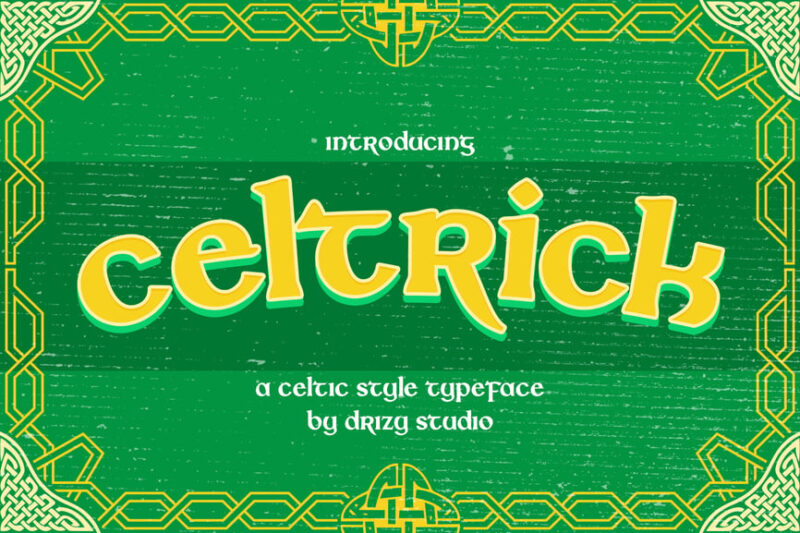
Celtrick is a sans-serif font that blends medieval and Celtic influences. This versatile typeface offers a modern take on Celtic fonts, making it suitable for contemporary designs that want to incorporate subtle Celtic elements without appearing overly traditional.
Eloanora – Medieval Blackletter Font

Eloanora is a decorative serif font that combines medieval blackletter style with magical elements. This Celtic-inspired typeface is perfect for creating mystical and enchanting designs, ideal for fantasy book covers, game titles, or Celtic-themed event materials.
Inkwell Scribe – Medieval Typeface
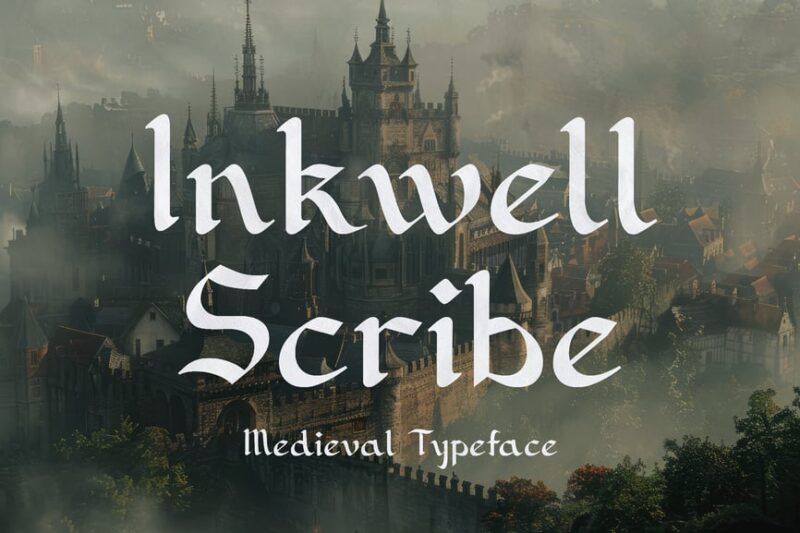
Inkwell Scribe is a serif medieval typeface that captures the essence of Celtic calligraphy. This font’s elegant and historical appearance makes it ideal for creating authentic-looking Celtic documents, invitations, or adding a touch of medieval charm to modern designs.
Enchant – Mystical 1600s Typeface
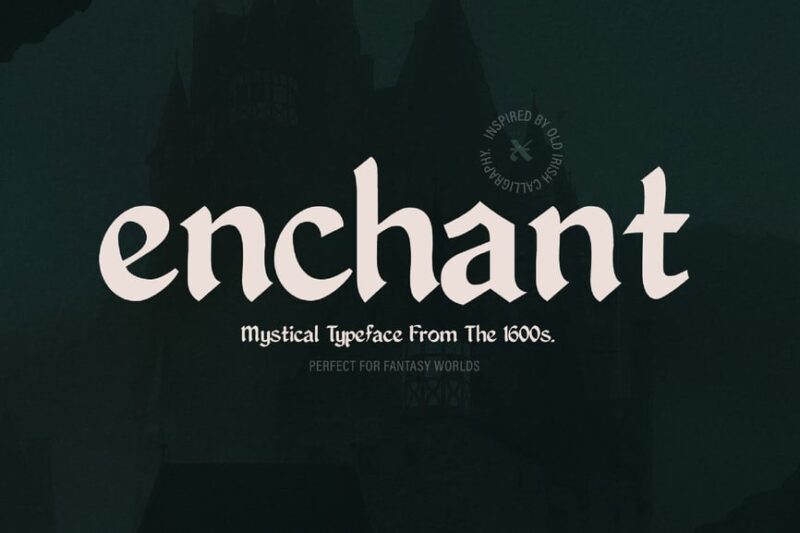
Enchant is a decorative Celtic font inspired by 17th-century mystical typography. This typeface combines medieval and magical elements, making it perfect for creating spellbinding designs with a Celtic flair, such as book covers, posters, or themed event materials.
Bricius – Display Celtic Typeface
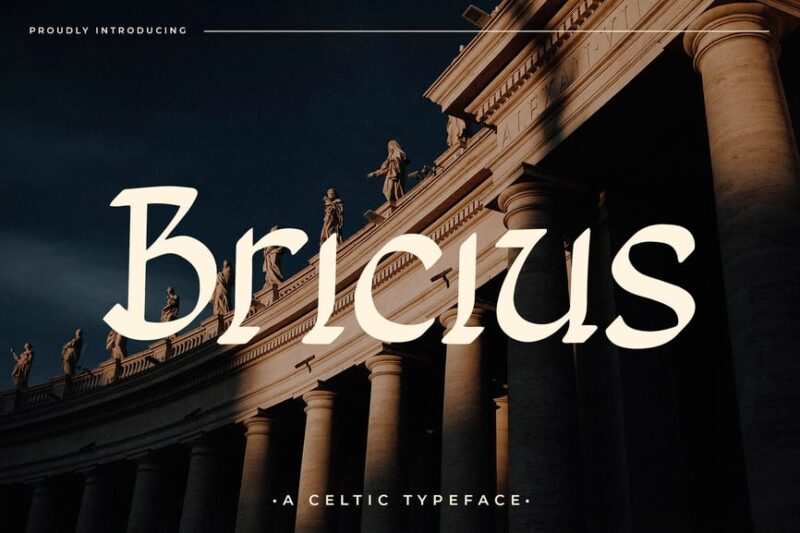
Bricius is a decorative display Celtic typeface that draws inspiration from ancient designs. This font’s unique and ornate characters make it ideal for creating eye-catching headlines, logos, or packaging designs that require a strong Celtic presence with a touch of antiquity.
Synthetic Stone – Medieval Crafted Font

Synthetic Stone is a versatile Celtic font that combines serif, script, and decorative elements. This medieval-inspired typeface offers a hand-crafted feel, making it perfect for creating authentic-looking Celtic designs for branding, packaging, or historical-themed projects.
Darklands – A Blackletter Font
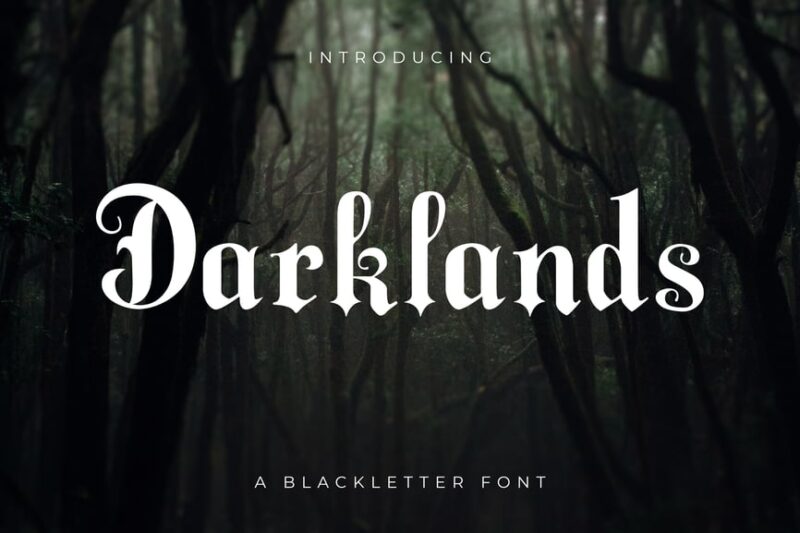
Darklands is a decorative blackletter font with a unique twist on Celtic typography. While not strictly Celtic, this font’s bold and edgy style can be used to create modern designs with a hint of medieval influence, perfect for music albums, posters, or urban-themed projects.
Lacoste Celtic – A Stylish Serif

Lacoste Celtic is a stylish serif font that brings a touch of elegance to Celtic typography. This typeface is ideal for creating sophisticated designs with a subtle Celtic influence, making it perfect for jewelry branding, high-end packaging, or luxury-themed projects.
Serkan – A Celtic font

Serkan is a decorative Celtic font that blends medieval and Celtic elements. This typeface offers a unique take on traditional Celtic design, making it suitable for creating distinctive logos, headlines, or themed materials that require a fresh approach to Celtic typography.
Celtoria
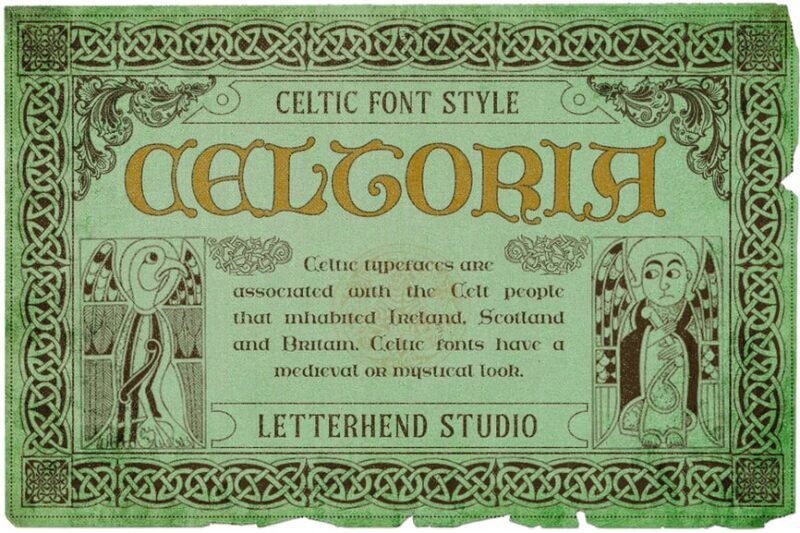
Celtoria is a decorative font that embodies the spirit of medieval and Celtic design. This typeface’s intricate details and ornate characters make it perfect for creating authentic-looking Celtic-inspired artwork, logos, or themed event materials that require a strong historical presence.
TF-Gaelic
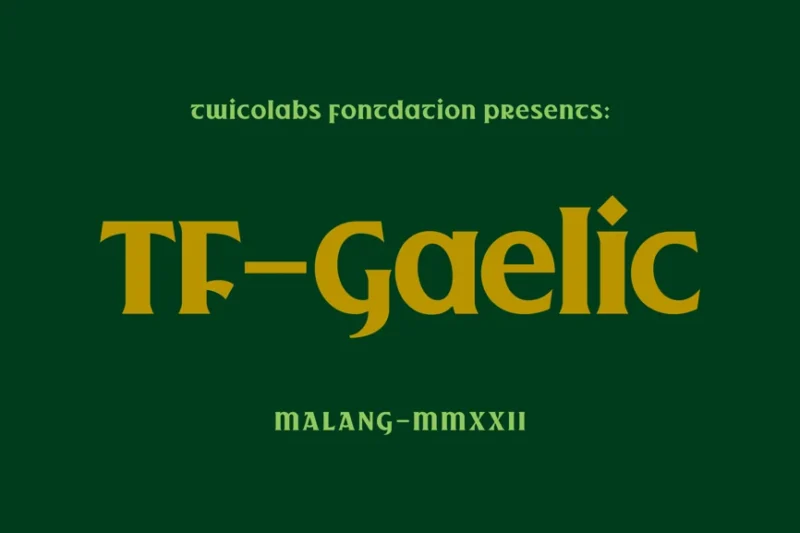
TF-Gaelic is a serif and decorative font that offers a unique blend of Celtic and Indian influences. While primarily Celtic in nature, this typeface’s versatility allows it to be used in a variety of contexts, from traditional Irish pub signage to modern, fusion-inspired designs.
Khalif
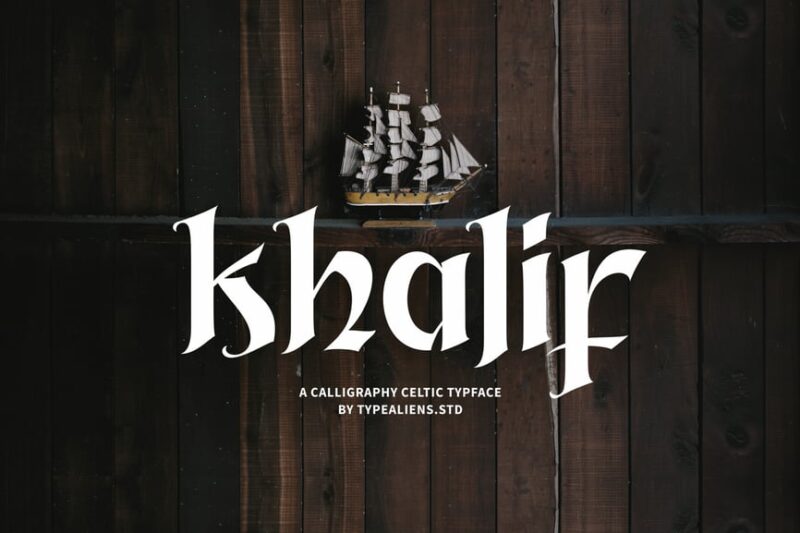
Khalif is a script and handwritten serif font that combines Irish and ancient elements. This Celtic-inspired typeface offers a more fluid and organic approach to Celtic design, perfect for creating invitations, logos, or packaging with a touch of historical Irish charm.
Old North
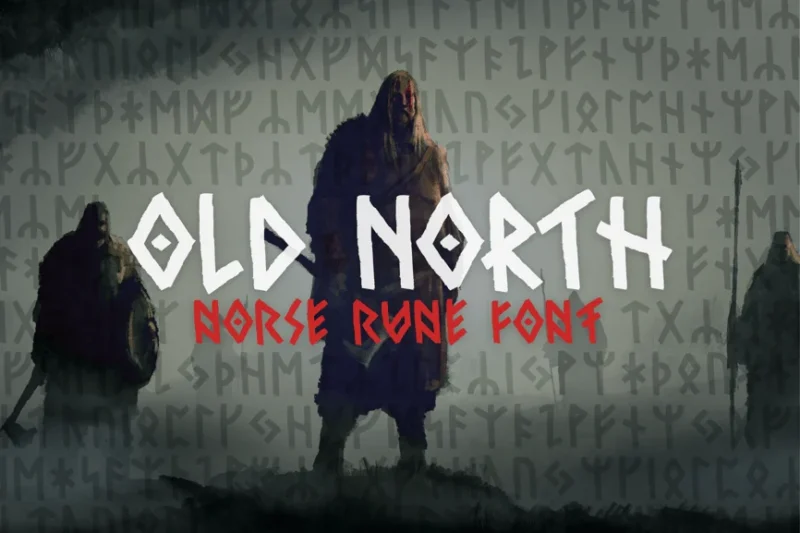
Old North is a script and handwritten font that blends fantasy and Celtic influences. This typeface’s unique character makes it ideal for creating Celtic-inspired designs with a touch of whimsy, perfect for book covers, game titles, or themed event materials.
Old Scotch Font
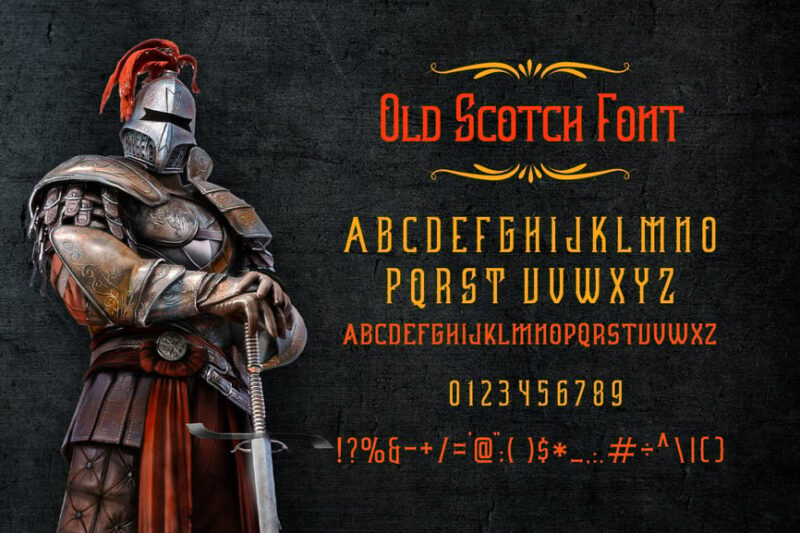
Old Scotch Font is a serif typeface that captures the essence of Scottish and Celtic typography. This font’s traditional appearance makes it perfect for creating authentic-looking Celtic designs, particularly those with a Scottish theme, such as whisky labels or heritage branding.
MILWAUKES
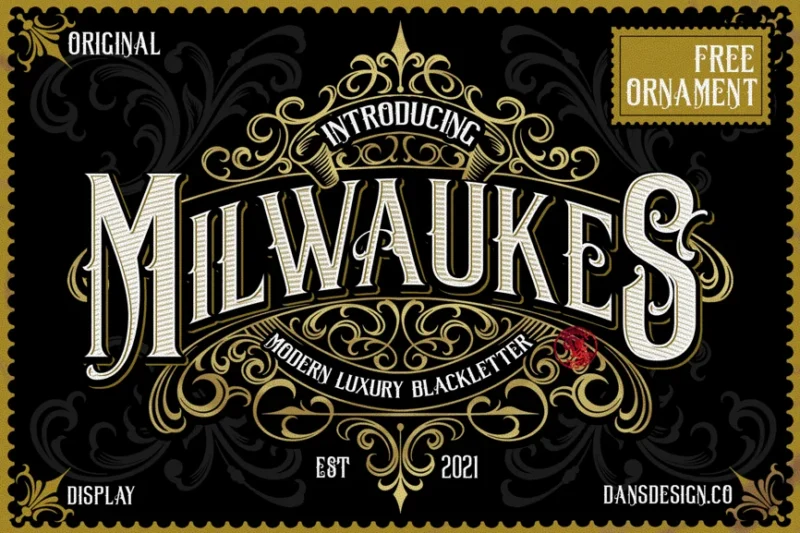
MILWAUKES is a serif and decorative font that combines Victorian and ancient elements. While not strictly Celtic, this typeface can be used to create designs with a historical feel that complement Celtic-inspired projects, particularly those requiring a blend of different eras.
Eachtra

Eachtra is a serif font with decorative symbols that blend gothic and Celtic influences. This typeface’s unique character set makes it ideal for creating distinctive Celtic-inspired designs, perfect for book covers, game titles, or themed event materials with a touch of mystery.
Piera – Uncial Font

Piera is a serif uncial font that draws inspiration from Greek and historical typography. This Celtic-inspired typeface offers a unique blend of ancient styles, making it perfect for creating authentic-looking historical documents, logos, or designs that require a touch of classical elegance.
Lansdowne
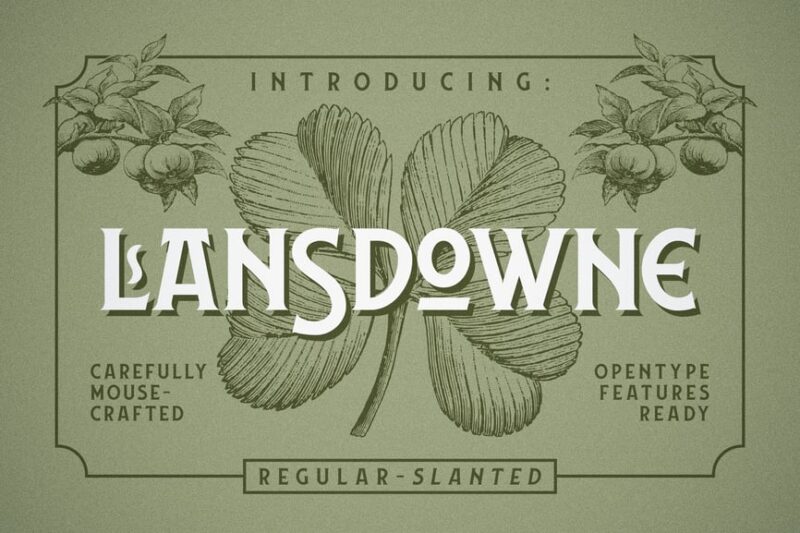
Lansdowne is a versatile serif font with decorative symbols that combine Celtic and medieval elements. This typeface’s rich character set makes it ideal for creating intricate Celtic-inspired designs, perfect for branding, packaging, or themed materials that require authentic historical detailing.
What Makes a Font “Celtic”?
Celtic fonts aren’t just regular typefaces with a few decorative flourishes thrown on top. They’re deeply rooted in centuries-old traditions of Irish and Scottish manuscript illumination, stone carving, and metalwork.
The magic lies in several key characteristics that separate authentic Celtic fonts from mere decorative imposters:
Intricate Knotwork and Interlacing True Celtic fonts feature the elaborate interwoven patterns that made Celtic art famous. These aren’t random squiggles – they follow specific mathematical principles that create those mesmerizing endless knots.
Uncial Letter Structure Many Celtic fonts draw inspiration from uncial scripts used by medieval scribes. These feature rounded letterforms without the sharp angles of later Gothic scripts, giving them a more organic, flowing feel.
Ornate Initial Capitals Celtic manuscripts were famous for their elaborate illuminated initials. The best Celtic fonts capture this tradition with decorative capital letters that could serve as artwork on their own.
Textural Richness Celtic fonts often incorporate textures reminiscent of aged parchment, weathered stone, or hammered metal – materials that were central to Celtic artistic traditions.
Celtic Fonts vs. Irish Fonts: Understanding the Difference
Here’s where things get interesting – and often confusing. While “Celtic” and “Irish” fonts are frequently used interchangeably, they’re not exactly the same thing.
Celtic fonts encompass the broader Celtic cultural tradition, which includes Irish, Scottish, Welsh, Breton, Cornish, and Manx heritage. These fonts draw from the shared artistic traditions of all Celtic peoples, including their common use of knotwork, spiral patterns, and illuminated manuscripts.
Irish fonts, on the other hand, specifically focus on typography traditions from Ireland. While they share many characteristics with broader Celtic fonts, Irish fonts might incorporate elements more specific to Irish culture, such as references to the Book of Kells or distinctly Irish Gaelic letterforms.
Think of it this way: all Irish fonts are Celtic, but not all Celtic fonts are specifically Irish. It’s like saying all shamrocks are clovers, but not all clovers are shamrocks.
The History Behind Celtic Typography
To truly appreciate Celtic fonts, we need to dive into their fascinating backstory. Celtic typography didn’t emerge in a vacuum – it’s the product of centuries of artistic evolution across the Celtic world.
The story begins in the early medieval period, around the 6th century, when Celtic monks began creating illuminated manuscripts. These weren’t just books – they were works of art that combined text with intricate decorative elements.
The most famous example is the Book of Kells, created around 800 AD by Irish monks. This masterpiece showcased the Celtic approach to letterforms: each page was a carefully orchestrated dance between text and decoration, where the letters themselves became part of the artwork.
Celtic scribes developed distinctive letter shapes that were both functional and beautiful. They favored rounded forms over angular ones, created elaborate initial capitals that could take days to complete, and integrated decorative elements seamlessly into the text flow.
This tradition continued through stone carving, metalwork, and other Celtic arts. The same principles that guided manuscript illumination influenced how Celts approached all forms of visual communication.
The Best Celtic Fonts of 2026
[Placeholder for comprehensive list of 25-30 Celtic fonts with descriptions and use cases]
How to Choose the Perfect Celtic Font for Your Project
Selecting the right Celtic font isn’t just about picking the prettiest option – you need to consider your project’s specific needs and context.
Consider Your Audience Are you designing for fantasy enthusiasts who’ll appreciate authentic medieval details? Or creating something for a broader audience that needs immediate visual impact? More historically accurate fonts work better for scholarly projects, while stylized versions might be perfect for entertainment applications.
Think About Legibility Celtic fonts can range from highly readable to practically hieroglyphic. For body text, choose fonts that maintain good legibility. Save the ultra-ornate options for headlines, logos, or decorative elements.
Match the Mood Different Celtic fonts evoke different emotions. Some feel ancient and mysterious, others playful and whimsical. Consider whether you want your design to feel scholarly, mystical, festive, or dramatic.
Consider Your Medium A font that looks stunning in print might become an illegible mess on screen. Test your chosen Celtic font across all intended applications before committing.
Where to Use Celtic Fonts (And Where to Avoid Them)
Celtic fonts have their place, but they’re not universally appropriate. Here’s where they shine – and where they don’t.
Perfect Applications:
- Fantasy book covers and gaming materials
- Irish pub branding and Celtic restaurant menus
- Historical societies and museum displays
- Celtic music album covers and festival materials
- Wedding invitations with Celtic themes
- Tattoo designs and artistic projects
- St. Patrick’s Day promotional materials
Where to Think Twice:
- Corporate business communications
- Technical documentation or legal documents
- Modern tech company branding
- Medical or pharmaceutical materials
- Financial services (unless specifically Celtic-themed)
- Children’s educational materials (unless teaching about Celtic culture)
Tips for Using Celtic Fonts Effectively
Getting the most out of Celtic fonts requires more finesse than your average typeface. Here are some pro tips:
Layer Thoughtfully Celtic fonts work beautifully when layered with textures, backgrounds, or other decorative elements. Think aged parchment, stone textures, or metallic finishes.
Mind Your Spacing The intricate details in Celtic fonts can create optical spacing issues. Don’t be afraid to adjust letter spacing manually to achieve better visual balance.
Pair Wisely When combining Celtic fonts with other typefaces, choose simple, clean fonts that won’t compete for attention. Let the Celtic font be the star.
Size Matters Celtic fonts often need to be larger than regular fonts to maintain legibility. Don’t be afraid to go big with headlines and important text.
Respect the Culture Remember that Celtic fonts represent real cultural traditions. Use them respectfully and avoid perpetuating stereotypes or clichés.
Common Celtic Font Mistakes to Avoid
Even experienced designers can stumble when working with Celtic fonts. Here are the most common pitfalls:
Overdoing the Ornamentation More decorative elements don’t always mean better results. Sometimes restraint creates more powerful designs than going full medieval manuscript.
Ignoring Context A font that works perfectly for a fantasy novel might look ridiculous on a business card. Always consider your design’s context and purpose.
Poor Font Combinations
Mixing multiple decorative fonts rarely works well. If you’re using a Celtic font, pair it with something clean and simple.
Sacrificing Readability No matter how beautiful a Celtic font looks, it’s worthless if people can’t read it. Legibility should always be your first priority.
Celtic Fonts in Digital Design
Working with Celtic fonts in digital environments presents unique challenges and opportunities. Here’s what you need to know:
Web Font Considerations Many Celtic fonts are quite large files due to their intricate details. Consider loading times and have fallback fonts ready for slower connections.
Screen Optimization Details that look stunning in print can become muddy on screens. Test your Celtic fonts across different devices and screen resolutions.
Accessibility Concerns Highly decorative fonts can be difficult for people with dyslexia or other reading challenges. Always provide alternatives or use Celtic fonts sparingly.
The Future of Celtic Typography
Celtic fonts aren’t just relics of the past – they’re evolving for modern applications. Contemporary type designers are finding new ways to honor Celtic traditions while meeting today’s design needs.
We’re seeing more Celtic fonts optimized for digital use, with cleaner letterforms that maintain the Celtic spirit while improving legibility. Some designers are creating modular Celtic font systems that let users adjust the level of ornamentation based on their needs.
There’s also growing interest in authentic historical reproduction. Type designers are studying original manuscripts more carefully than ever, creating fonts that capture not just the look of Celtic letterforms, but their underlying principles and proportions.
Conclusion: Embracing the Celtic Spirit in Your Designs
Celtic fonts offer something rare in our digital age: a direct connection to centuries of artistic tradition. They remind us that typography can be more than just functional communication – it can be art, culture, and history rolled into beautiful letterforms.
Whether you’re designing a fantasy epic cover, creating materials for a Celtic festival, or simply want to add some historical gravitas to your project, the right Celtic font can transform ordinary text into something magical.
Remember, though, that with great typographic power comes great responsibility. Celtic fonts carry the weight of cultural heritage, so use them thoughtfully and respectfully. When done right, they can elevate your designs from merely attractive to truly memorable.
So next time you’re tempted to reach for that same old sans serif, consider taking a journey back through the mists of time. Your designs – and your audience – might just thank you for it.
The ancient Celts believed that art had the power to connect the earthly and divine realms. In a way, that’s exactly what a great Celtic font does – it bridges the gap between our modern world and the timeless beauty of Celtic artistic tradition. And in 2026, that connection feels more valuable than ever.

